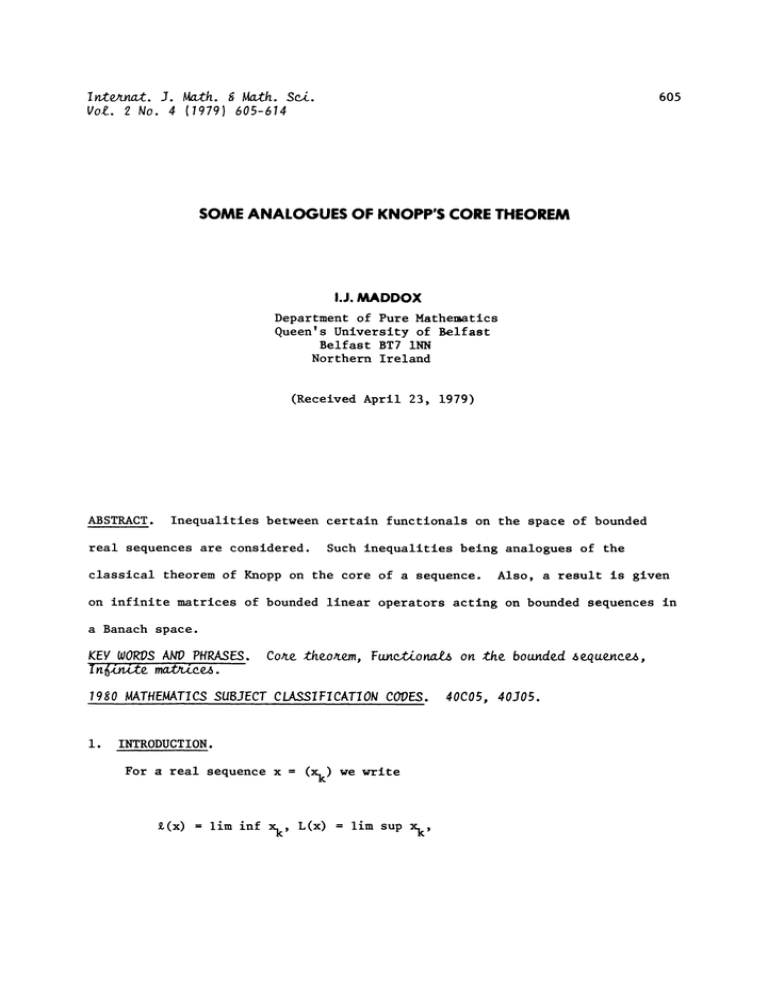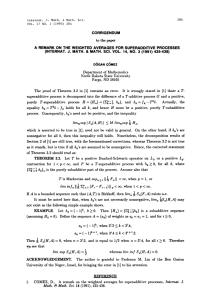KNOPP’S
advertisement

I nternat. J. Math. Math. Sci.
Vol. 2 No. 4 (1979) 605-614
605
SOME ANALOGUES OF KNOPP’S CORE THEOREM
I.J. MADDOX
Department of Pure Mathematics
Queen’s University of Belfast
Belfast BT7 INN
Northern Ireland
(Received April 23, 1979)
ABSTRACT.
Inequalities between certain functlonals on the space of bounded
real sequences are considered.
Such inequalities being analogues of the
classical theorem of Knopp on the core of a sequence.
Also, a result is given
on infinite matrices of bounded linear operators acting on bounded sequences in
a Banach space.
KEY WORDS AND PHRASES.
Infinite
mees
Core theorem, Funonal on the bounded sequences,
1980 MATHEMATICS SUBJECT CLASSIFICATION CODES.
i
INTRODUCTION.
For a real sequence x
(x)
(xk) we write
lim inf xk, L(x)
lim sup
Xk,
40C05, 40J05.
606
I.J. MADDOX
x
I
x
I
+ x
y(x)
lira inf
Y (x)
lira sup
w(x)
inf {L(x + z)
2
lira sup
Ix l,
+
+ x
+
+ x
k
k
bs},
z
lxll
sup
p(x)
+ x
2
sup
q(x)
lira inf
Ix l.
In the definition of w we use bs to denote the space of all ’bounded
series’
more precisely:
n
bs
If A
(ank)
{z
SUPn
IkE=l
<
is an infinite matrix of real, or complex, numbers, we write
Ax
(lankxk),
where all sums are from k
1 to k
--=,
Let X be a Banach space with norm
unless otherwise indicated.
lxll
and let B(X) be the Banach space
of bounded linear operators on X into X with the usual operator norm.
of bounded X-valued sequences is denoted by
each x e
,(X).
(X),
with
lxll
sup
The space
nllnll,
By c(X) we denote the space of convergent X-valued sequences.
If G and H are real functionals on
(X), and M
G < MH means that G(x) < MH(x) for all x
> 0
is a real number, then
(X).
In connection with a real matrix A, we shall write, for example, LA < L
to mean that
x
Ax exists for all x
(R)
and that L(Ax) < L(x) for all
(R).
Devi [I] refers to the result that:
and almost positive", as
the proof.
for
"LA
<
L if and only if A is regular
Knopp’s core theorem, and refers
to Cooke [2] for
Strictly speaking the result as stated does not seem to be given
ANALOGUES OF KNOPP’S CORE THEOREM
607
by Cooke, though the ingredients for a proof are there.
In Section 2 below we
indicate, for completeness, a brief proof of the result.
Using Knopp’s core theorem, Devi [I] proves that LA
is strongly regular and almost positive.
_< w
if and only if A
To say that A is strongly regular
is to say that A is regular and
Zlank-an,k+ll
/
0 (n + ).
In Section 2 we prove that LA < y is impossible, and that LA <
impossible.
is
Also, necessary and sufficient conditions are given for pA < q.
In Section 3 we give a theorem involving pA for bounded sequences from
X, and infinite matrices
2.
(Ank)
from B(X).
REAL BOUNDED SEQUENCES.
We first give exact conditions for LA
THEOREM I.
_<
L, as mentioned in Section I.
LA < L if and only if A is regular and
(2.1)
PROOF.
L(A(-x))
_<
For the necessity, let x
c(R).
Then (x)
L(x)
lira x
and
L(-x), whence
lira x
<
n
(Ax) < L(Ax.)
_<
L(x)
lira x
n
and so Ax
c(R) with lim (Ax)
lira Xn, which implies A is regular. By the
n
Silverman-Toeplitz theorem, see e.g. Maddox [3], p.165, it follows that
H
Zank
lira
-+
SUPn
.lakl
1 (n -+ =o),
<
-,
(2.2)
(2.3)
608
I.J. MADDOX
0 (n
ank +
/
,
(2.4)
each fixed k).
From (2.2), (2.4), e.g. Agnew [4], there exists y
I and L(Ay)
I
<_
(R)
<
IYll
such that
Hence, by (2.3),
H.
infn llankl
lira
E
< lira
SUPn
llankl
<
L(y)
<
I,
which implies (2. I).
E
(R),
lankl
+ (sup
k-m
For the sufficiency, let x
m > I then
lxll
<
lankxk
-
k<m
A be regular and let (2.1) hold.
If
k)
x
Applying the operator lira lira sup we obtain L(Ax) < L(x), which completes
m
n
the proof.
m (R),
We have, o__n
THEOREM 2.
<y<Y_<w<L_< S<
By Theorem I, letting A be the (C,l) matrix, we have
PROOF.
i.e.
Now take x
I
k
A
k
O.
(R) and z
b s.
k
k
r.
e
I
x.
A,
Taking lira
_<
suPk
+
e_K
in (2.5), and applying Theorem 1 with
L(x + z), whence Y < w by the definition of w.
(0,0,0,...)
inequalities are trivial.
Then
Z (x + z
i
i
i=l
k
I
i=l
(C,I), we get Y(x)
Since
<
It is trivial that y < Y.
< y.
where lira
I1.11.
bs it is immediate that w < L, and the remaining
ANALOGUES OF KNOPP’ S CORE THEOREM
The facts that LA < y, and LA _<
609
are impossible are special cases of
the following result.
THEOREM 3.
Let B be any regular almost positive matrix.
Then there is
no matrix A such that LA < B.
PROOF.
Suppose, if possible, there exists such an A.
LB < L, and so LA < B < LB
_<
Theorem 1 implies
L, whence A is regular.
By the theorem of Steinhaus, see e.g. Cooke [2], p.75, there exists
z
E
=(R)
Since LA < LB we have (Bz) < (Az), and
such that (Az) < L(Az).
so
(Bz) < L(Az)
a contradiction.
<
(Bz),
This proves the theorem.
The statement prior to Theorem 3 follows on taking B to be either the
(C,I) matrix, or the unit matrix.
THEOREM 4.
The following are equivalent:
(2.6)
pA < q,
A maps bounded sequence.s..i..n.to
r.
PROOF.
lank
/
O (n
/
nul.l
sequences,
=).
The equivalence of (2.7) and (2.8) is well-known, see e.g.
Maddox [3], p.169.
We shall prove that (2.6) is equivalent to (2.8).
If (2.8) holds then, for all x
im sup n
lZankXk
E
E (R),
=0,
(2.7)
610
I.J. MADDOX
which implies (2.6).
the Banach space
Conversely, let (2.6) hold.
(R)
Also, choosing x
I, xn
k
SUPnT. lank
whence
..lam(1)ll
<
is bounded on
by the Banach-Steinhaus theorem.
SUPn
7.1ank
d > O.
Choose m(1) > I
d/IO and
IZIam(1)kl
Define k(1)
7.ankXk
O otherwise, we must have (2 4)
Suppose, if possible, that lira
such that
<
Then
d
<
d/IO.
I and choose k(2) > 2 + k(1) such that
k(2)
lam(1)kl
<
d/IO.
Next choose m(2) > m(1) such that
k(2)
7.
I
lam(m)kl
d/IO,
<
Ila(m)kl
d
d/IO,
<
and choose k(3) > 2 + k(2) such that
k(3)
lam(2)kl
<
d/IO.
Proceeding inductively we now define a sequence x by
Then
lxll
_<
x
k
sgn
x
k
0
I and lira inf
p (/Ix)
But for m
am(r) k
for k(r) < k < k(r+l), r z I,
for k
IXkl
r _> O.
O, so (2.6) implies
O.
m(r), with r
k(r+l),
(2.9)
>
I, we have
ANALOGUES OF KNOPP’S CORE THEOREM
lamkxk
where l
I
> l
llamk
d/5,
denotes a sum over k(r) < k < k(r+l).
r.llamk
d
r.amkxk
> d
<
611
Also, we have
3d/lO,
and so
3dllO
diS
d12.
(2.10)
Since (2.10) holds for infinitely many m it follows that
p(Ax)
_>
But (2.11) contradicts (2.9), so d
3.
(2.11)
d/2.
O, and the proof is complete.
BOUNDED SEQUENCES IN A BANACH SPACE.
Define, for each x
(xk) e
(X),
G(X)
lim sup
H(x)
inf {G(x+z)
z e bs(X)},
where
n
bs(X)
{z
SUPnllk__E I Zkl
< =}.
Thus G and H many be regarded as the Banach space analogues of p and w which
appeared earlier.
By GA
_<
MH we mean that G(Ax) < MH(x) for all x e
Ax
with
Ank
e
B(X).
(EAnkXk),
(X), where
I.J. MADDOX
612
(X), and that 0 -< H(x)
It is clear that bs(X)
x
<
G(x) <
for all
(x).
Also, since -x e bs(X) whenever x e bs(X) we have that
O on bs(X).
H(x)
In the following theorem we need the ideas of the group norm of a
k)
sequence (B
from B(X), see e.g. Lorentz and Macphail [5]:
n
sup[[
]](Bk)]!
BkXk]
E
k--1
in the closed unit sphere of X.
where the supremum is over n > 1 and x
k
We write
R
nm
(Anm,
An
...)
,m+l
for the mth tail of the nth row of A
(Ank).
Also, we define
and
AAnk Ank-An,k+l,
(A ,m’
R
nm
AAn
,m+l
...).
We now prove
THEOREM 5.
Ank
[IRnlI
PROOF.
Then GA < MH if and only if
Let M z O.
<
-O (n
and
/
(2.12)
=, each k),
IRnmIl
+0 (m
lRnmll
limm
lim
SUPn
limm
lim
SUPn [IARnm[[
/
% each
n),
(2.13)
<M,
(2.14)
0
(2.15)
We remark that, in (2.12), the convergence refers to the topology
ANALOGUES OF KNOPP’S CORE THEOREM
613
of pointwise convergence.
For the sufficiency, let x
(X), and z
E
E
bs(X).
By Maddox r6, THEOREM I]
the conditions (2.12), (2.13), (2.14) imply GA _< MG, whence GA(x+z) _< MG(x+z)
and so
G(Ax) < MG(x+z) + G(Az).
(2.16)
Now
r-I
r
Y.
LA-kZk
k=l
where s
s e
(X),
+
s
nr r
Y.
k=l
AAnk Sk’
lAnrSrll
(2.17)
IAnrll lSrll’
-<
k. Since
it follows from (2.13) and (2.17) that, for each n,
z
k
A
I
+ z
2
+
+ z
I
EAnk zk
(2.18)
AAnk sk
By Maddox [6, COROLLARY to THEOREM I], the conditions (2.12)
imply that AA
=(X)_
/
c
o
and since
(2.15)
(X), where c o (X) denotes the null X-valued sequences.
Hence from (2.18) we have G(Az)
O, whence (2.16) yields G(Ax)
<
MG(x+z).
follows that G(Ax) -< MH(x), which proves the sufficiency.
For the necessity, if GA < MH then GA _< MG so that (2.12)
(2.14) hold
by Maddox [6, THEOREM I].
Now take any y e
(X)
x
Thus x
I
and define x
+ x
2
+
+
I
Xn
b s(X) and
ZAnkXk EAAnkYk.
YI’ x2
Yn"
Y2-Yl
so that
It
I.J. MADDOX
614
Hence G(AAy)
G(AAy)
G(Ax)
O on
(X)
_<
MH(x)
O, since H(x)
(X)
which implies AA
[6, COROLLARY TO THEOREM I].
O on
+ c
o
(X).
Consequently,
(X), whence (2.15) holds by
This proves the theorem.
REFERENCES
i.
Devi, S.L.
(1976)
2.
Cooke, R.G.
3.
Maddox, l.J.
Banach limits and infinite matrices, J. London Math. Soc. 12
397-401.
Infinite matrices and
sequence spaces, Macmillan, 1950.
Elements of Functional Analysis, Cambridge University Press,
1970.
4.
Agnew, R.P.
Abel transforms and partial sums of Tauberian series, Annals
of Math. 50 (1949)
5.
Lorentz, G.G. and Macphail, M.S.
A. Robinson,
6.
110-117.
Maddox, l.J.
Tra.n.s... ROY."
Unbounded operators and a theorem of
Soc. Canada, Sec. III (3)
4__6 (1952)
33-37.
Matrix maps of bounded sequences in a Banach space, Proc.
American Math. Soc. 63 (1977)
82-86.






